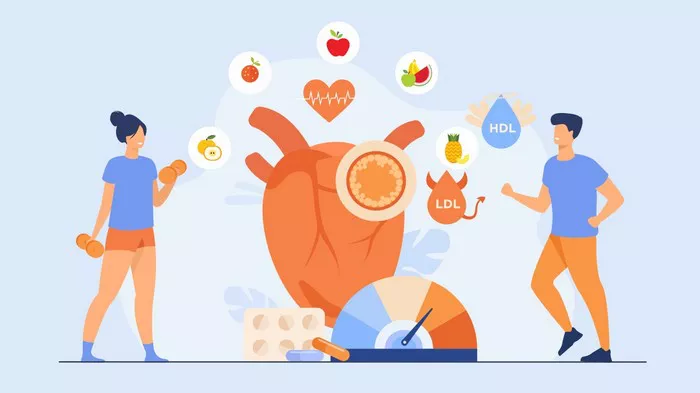In the realm of cardiovascular health, one of the key players is cholesterol. This waxy, fat-like substance plays a crucial role in building cell membranes and producing certain hormones. However, when levels of cholesterol become too high, especially low-density lipoprotein (LDL) cholesterol often referred to as “bad” cholesterol, it can lead to atherosclerosis and increase the risk of heart disease.
Fortunately, there are natural ways to manage cholesterol levels, and one of the most effective methods is regular exercise. This article delves into the science behind how exercise reduces cholesterol and promotes a healthier heart.
Understanding Cholesterol
Before delving into the mechanisms of how exercise impacts cholesterol, it’s essential to understand the different types of cholesterol and their roles in the body.
1. LDL Cholesterol: Known as low-density lipoprotein cholesterol, LDL carries cholesterol from the liver to the cells. However, if there’s an excess, it can build up in the arteries, leading to plaque formation and atherosclerosis.
2. HDL Cholesterol: High-density lipoprotein cholesterol, or HDL, is often termed “good” cholesterol because it helps remove LDL cholesterol from the bloodstream, transporting it back to the liver for disposal.
3. Triglycerides: These are another type of fat in the blood that, when elevated, can also contribute to heart disease.
The Role of Exercise
Regular physical activity has long been recognized as a cornerstone of heart health. When it comes to cholesterol management, exercise influences several factors that contribute to a healthier lipid profile.
1. Increased HDL Cholesterol: One of the most significant benefits of exercise is its ability to raise HDL cholesterol levels. Aerobic exercise, such as jogging, swimming, or cycling, has been shown to boost HDL levels, enhancing the body’s ability to remove excess cholesterol from the bloodstream.
2. Reduction in LDL Cholesterol: Exercise can also lower LDL cholesterol levels, especially when combined with dietary changes. This reduction is attributed to improved metabolism and utilization of fats for energy during physical activity.
3. Weight Management: Exercise plays a vital role in weight management, and maintaining a healthy weight is crucial for cholesterol regulation. Excess body weight, especially around the waist, is linked to higher LDL cholesterol and triglyceride levels.
4. Improved Insulin Sensitivity: Regular exercise improves insulin sensitivity, which, in turn, helps regulate blood sugar levels. This is important because high blood sugar can contribute to elevated triglycerides and LDL cholesterol.
The Mechanisms Behind Exercise and Cholesterol Reduction
To understand how exercise reduces cholesterol, it’s essential to explore the physiological mechanisms involved.
1. Enhanced Lipoprotein Lipase Activity: Lipoprotein lipase (LPL) is an enzyme that breaks down triglycerides in the blood. Exercise stimulates LPL activity, leading to the breakdown of triglycerides and the utilization of fats for energy.
2. Activation of PPARs: Peroxisome proliferator-activated receptors (PPARs) are proteins that play a role in lipid metabolism. Exercise activates PPARs, promoting the breakdown of fats and the regulation of cholesterol levels.
3. Reduction in VLDL Production: Very-low-density lipoproteins (VLDL) are precursors to LDL cholesterol. Regular exercise reduces the production of VLDL in the liver, which indirectly lowers LDL cholesterol levels.
4. Anti-Inflammatory Effects: Chronic inflammation is a key factor in atherosclerosis and heart disease. Exercise has anti-inflammatory effects, reducing inflammation markers and improving overall cardiovascular health.
Designing an Exercise Regimen for Cholesterol Management
When it comes to using exercise to reduce cholesterol, it’s important to design a comprehensive and sustainable regimen. Here are some key considerations:
1. Aerobic Exercise: Include activities like brisk walking, jogging, cycling, or swimming for at least 150 minutes per week, as recommended by health guidelines.
2. Strength Training: Incorporate resistance training exercises to build muscle mass, which can further improve metabolism and cholesterol levels.
3. Consistency: Consistency is key. Aim for regular, weekly workouts to maintain the benefits of exercise on cholesterol.
4. Balanced Diet: Combine exercise with a heart-healthy diet rich in fruits, vegetables, whole grains, lean proteins, and healthy fats like those found in fish, nuts, and olive oil.
5. Consultation with Healthcare Provider: Individuals with existing health conditions or those on medications should consult their healthcare provider before starting a new exercise program.
Conclusion
Exercise is a powerful tool for reducing cholesterol and promoting overall cardiovascular health. By increasing HDL cholesterol, lowering LDL cholesterol, improving insulin sensitivity, and supporting weight management, regular physical activity addresses multiple factors contributing to heart disease risk. Incorporating exercise into a holistic approach to heart health, alongside a balanced diet and other lifestyle modifications, can lead to significant improvements in cholesterol levels and a reduced risk of cardiovascular events.

